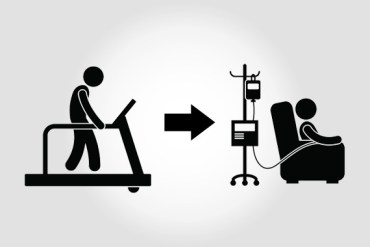Cancer patients who do rehabilitation before they begin treatment may recover more quickly from surgery, chemotherapy or radiation, some cancer specialists say. But insurance coverage for cancer “prehabilitation,” as it’s called, can be spotty, especially if the aim is to prevent problems rather than treat existing ones.
It seems intuitive that people’s health during and after invasive surgery or a toxic course of chemo or radiation can be improved by being as physically and psychologically fit as possible going into it. But research to examine the impact of prehab is in the beginning stages.
 Prehabilitation is commonly associated with orthopedic operations such as knee and hip replacements or cardiac procedures. Now there’s growing interest in using prehab in cancer care as well to prepare for treatment and minimize some of the long-term physical impairments that often result from treatment, such as heart and balance problems.
Prehabilitation is commonly associated with orthopedic operations such as knee and hip replacements or cardiac procedures. Now there’s growing interest in using prehab in cancer care as well to prepare for treatment and minimize some of the long-term physical impairments that often result from treatment, such as heart and balance problems.
“It’s really the philosophy of rehab, rebranded,” says Dr. Samman Shahpar, a physiatrist at the Rehabilitation Institute of Chicago.
The main component of cancer prehab is often a structured exercise program to improve patients’ endurance, strength or cardiorespiratory health. The clinician establishes baseline measurements, such as determining how far a patient can walk on a treadmill in six minutes, and may set a goal for improvement. He also evaluates and addresses existing physical impairments, such as limited shoulder mobility that could be problematic for a breast cancer patient who will need to hold her shoulder in a particular position for radiation. Depending on the program, patients may also receive psychological and nutritional counseling or other services.
Some early research suggests prehab may improve people’s ability to tolerate cancer treatment and return to normal physical functioning more quickly. In one randomized controlled trial of 77 people with colorectal cancer who were awaiting surgery, two groups of patients participated in an exercise, relaxation and nutritional counseling program. Half went through the program in the four weeks prior to surgery and half in the eight weeks after it.
Eight weeks after their surgery, 84 percent of prehab patients’ performance on a six-minute walking test had recovered to or over their baseline measurements compared with 62 percent of rehab patients, according to the study, published last year in Anesthesiology.
“Prehab could be a relatively cheap way to get people ready for cancer treatment and surgery, both of them stressors,” says Dr. Francesco Carli, a professor of anesthesiology at McGill University in Montreal who co-authored the study.
More study is needed to determine whether prehab actually improves cancer patients’ outcomes, experts say.
“There are some physiatrists who don’t believe in prehab,” says Catherine Alfano, vice president of survivorship at the American Cancer Society. “They feel like the science isn’t there yet.”
Insurance plans typically cover rehabilitation services such as physical therapy and occupational therapy. But patients can face problems with coverage such as preauthorization requirements and limits on visits. There may be even more coverage obstacles with prehab.
“What we need is a system that systemically screens people for problems with physical and mental health that is then coordinated with their oncology care,” Alfano says.
The STAR Program is one effort to accomplish that. It helps hospitals and cancer centers establish interdisciplinary teams to improve cancer rehabilitation services, including offering prehab services.
“What we know from the literature is that 65 to 90 percent of cancer patients could benefit from rehab services, but delivery of those services is often less than 5 percent,” says Dr. Julie Silver, an associate professor at Harvard Medical School who founded STAR — it stands for Survivorship Training and Rehab–in 2009.
The Peoria, Ill.-based Institute of Physical Medicine and Rehabilitation is STAR-certified. It was originally launched as a program to help breast cancer and other patients cope with problems associated with lymphedema, a swelling of the arms or legs following removal of lymph nodes. But it became clear that cancer patients could benefit from a much broader array of services, says Kate Horst, the institute’s director of research and clinical innovation. Now, in addition to occupational, physical and speech therapists, the institute also offers cancer patients acupuncture, oncology massage and nutritional counseling.
Many of their patients are referred by physicians for prehab following their cancer diagnosis, says Horst. Specialists do an evaluation to determine if patients need any prehabilition services. Some don’t, and they’re discharged.
“But most of the time, people are about to embark on the most difficult period of their lives, and they’ve already got some problems,” says Horst.
Please contact Kaiser Health News to send comments or ideas for future topics for the Insuring Your Health column.







